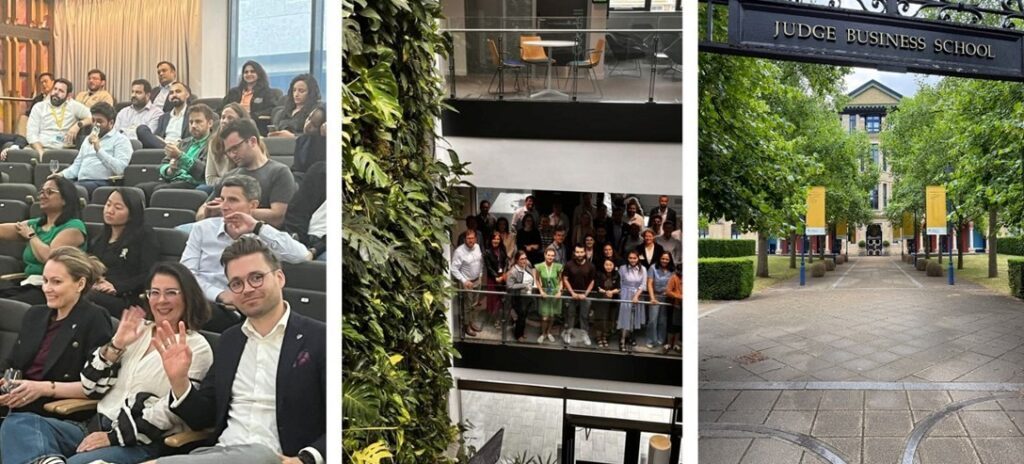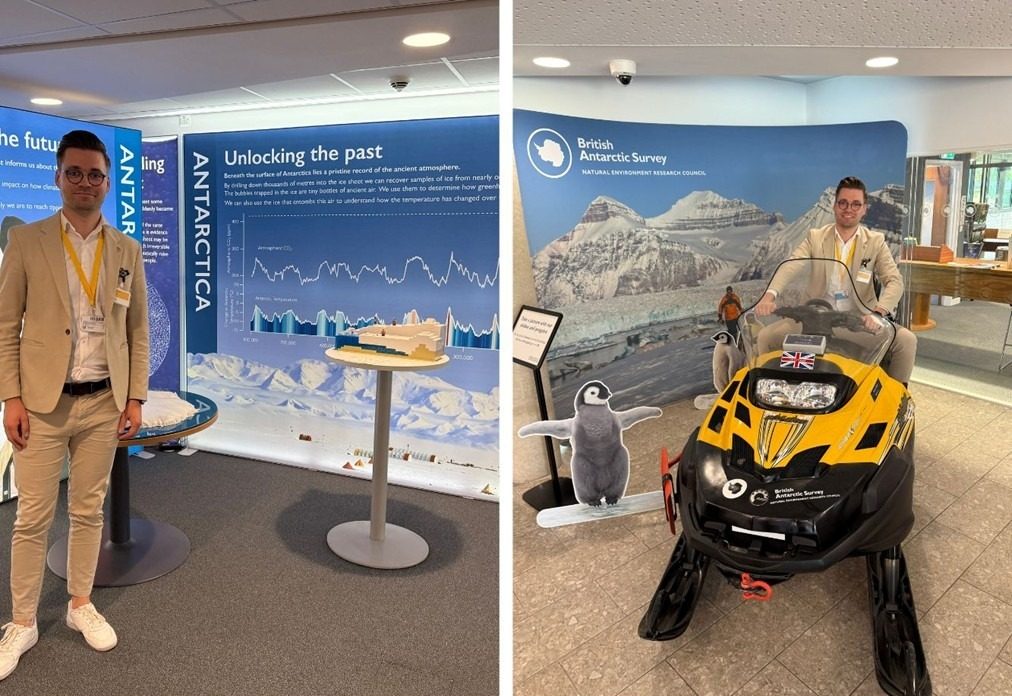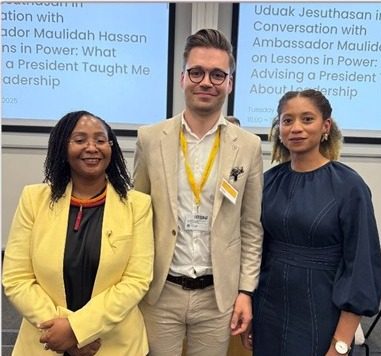After writing a blog post about the International Business Study Trip (IBST) to Brazil earlier this year, Karolis Jonuska (EMBA 2024) now shares his personal experiences, insights and reflections on Cambridge Ecosystem: ESG Week, an optional, thematic course with a focus on environmental, social and governance (ESG) that is designed to showcase Cambridge businesses.

Heatwaves, Hard Questions
This summer felt hotter than the last, again. Winters with blanket-white snow feel like ancient folklore, storms spin up overnight, and even the most hard-nosed CEOs now ask: Where does our money go? Who feels safe at work? Can people bring their whole selves to the office?
Those questions and my built-in scepticism travelled with me to Cambridge ESG Week. I arrived exactly as I did in Brazil: ready to be surprised but prepared to ask hard questions the moment a buzzword floated by.
Holding 20,000-Year-Old Ice
Day 1 took us to the British Antarctic Survey (BAS) headquarters. A researcher opened a cloudy cylinder of ice drilled kilometres beneath Antarctica’s surface. Inside the core, tiny bubbles – air last breathed 20,000 years ago – popped as the ice warmed. Climate change was literally fizzing through my fingers.
BAS scientists drove home a blunt lesson: sustainability budgets look like “nice-to-haves” until boards see them as risk controls credit ratings, stranded assets, customer loyalty, all crammed onto one slide. Then they showed us the other side of the puzzle: life on the ice shelf. Riding snowmobiles may sound like an adventure holiday but try it in minus-sixty wind chill with daylight that never ends. Suddenly, “environmental cost” stops being hypothetical.

Humans, Nudges & Policy Shifts
Professor Lucia Reisch (El-Erian Professor of Behavioural Economics and Policy, Porsche AG Advisory Board) and Professor Cass Sunstein (Harvard Law School, Barack Obama advisor, author of Nudge) explored how policy hinges on human habits, defaults, social proof, not just data. I loved the practical aspect of it – how to move ahead and gather support for difficult strategies in the face of adversity. Habits, defaults, social proof – move those levers, and glaciers of public opinion start to move.
Whiteout to Patent Black-Gold
Our next stop was the Schlumberger Cambridge Research Centre, proof that an oil-and-gas giant can still push hard on innovation. Managers there live in a paradox: success means encouraging experiments that will almost certainly fail. The higher the failure rate, the healthier the research pipeline and the numbers to back it up, with well over a hundred patents logged in just a few years for renewable energy technologies alone. It’s a reminder that most products we use – from pharma to food and transportation – are still rooted in oil, and progress hinges on taking scientific risks. We wrapped the evening with a networking talk by Ambassador Maulidah Bwanakheir Hassan, senior Tanzanian diplomat and policy adviser, whose stories from African politics reframed leadership through an ESG lens of community and resilience.
Pharma with a Planetary Prescription
The following morning, Andrés Pérez, Executive Director Sustainability at AstraZeneca (and fellow Cambridge graduate), laid out what full-spectrum responsibility looks like in pharma. They track not just carbon and water at the factory gate but every downstream droplet – waste-water chemistry, community health, even the emissions tied to staff travel.
When your product saves lives, you cannot treat environment and society as expendables – the entire value chain is important.
Holding 20,000-Year-Old Ice
Day 1 took us to the British Antarctic Survey (BAS) headquarters. A researcher opened a cloudy cylinder of ice drilled kilometres beneath Antarctica’s surface. Inside the core, tiny bubbles – air last breathed 20,000 years ago – popped as the ice warmed. Climate change was literally fizzing through my fingers.
BAS scientists drove home a blunt lesson: sustainability budgets look like “nice-to-haves” until boards see them as risk controls credit ratings, stranded assets, customer loyalty, all crammed onto one slide. Then they showed us the other side of the puzzle: life on the ice shelf. Riding snowmobiles may sound like an adventure holiday but try it in minus-sixty wind chill with daylight that never ends. Suddenly, “environmental cost” stops being hypothetical.
Silicon and the Invisible Hand
My inner tech-kid practically levitated walking into Arm (I worked summer jobs just to afford my first “smart” phones, now a museum piece beside today’s iPhones.) Almost all the gadgets I use rely on or are influenced by Arm’s technologies. Arm’s revenue model is pure licensing, yet its blueprints live in almost every handset on the planet. We talked AI, bottlenecks, and how governance choices and culture shaped the company from day one. Lesson learned: the smaller the transistor, the bigger the governance headache.
Horsepower Meets Net-Zero
Evening brought Dr Benedikt Finkenauer, Director of Sustainability at Porsche AG, to the podium. Translating a brand built on engine roar into an electric future is part engineering, part psychology, part diplomacy with die-hard customers. Beneath the hood of glossy marketing lies a slow, thorny rebuild – supply-chain audits, battery strategy, circular-economy targets, production choices.
When ESG Meets Crypto & FinTech
Day 3 wrapped with two very different but equally eye-opening sessions. First, the Cambridge Conservation Initiative (CCI) brought together representatives from UN agencies, international NGOs and academic researchers to show how capital can be channelled into biodiversity using different models. Case studies covered different ways climate financing can work, both on public and private levels.
Then, at the Provost’s Lodge at King’s College, Tim Bestwick, Chief Development Officer and Deputy CEO at the UK Atomic Energy Authority, unpacked the state of fusion and advanced nuclear: long time-horizons, multi-billion risk, and the ethics of betting on technology that still frightens some.
Conclusion
All of this made me think about my own patch: crypto and FinTech. The topic wasn’t on the official agenda, but sitting there I kept replaying the EU’s looming rules on digital assets. Fast-moving code colliding with slow-moving regulation feels a lot like fusion research – huge promise, equally huge uncertainty. EU regulators are looking at crypto from the ESG angle as well, with requirements to publish disclosures for those who operate in the area. I believe the whole community can learn to treat ESG not as compliance theatre but as its licence to operate. That mindset is coming faster than many in the space realise and, after Cambridge, I plan to be ready.


Andres Perez (AstraZeneca)



Leave a Reply